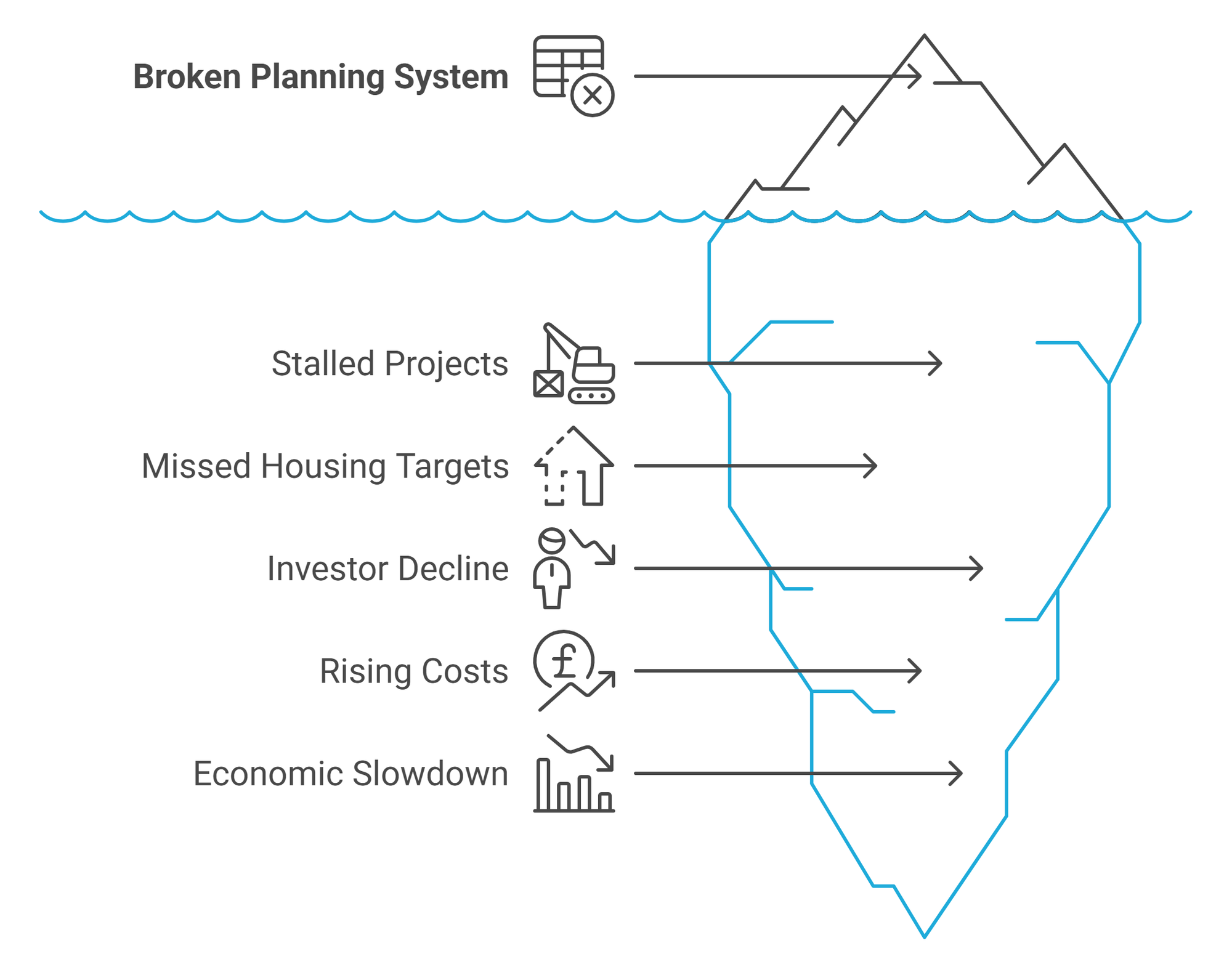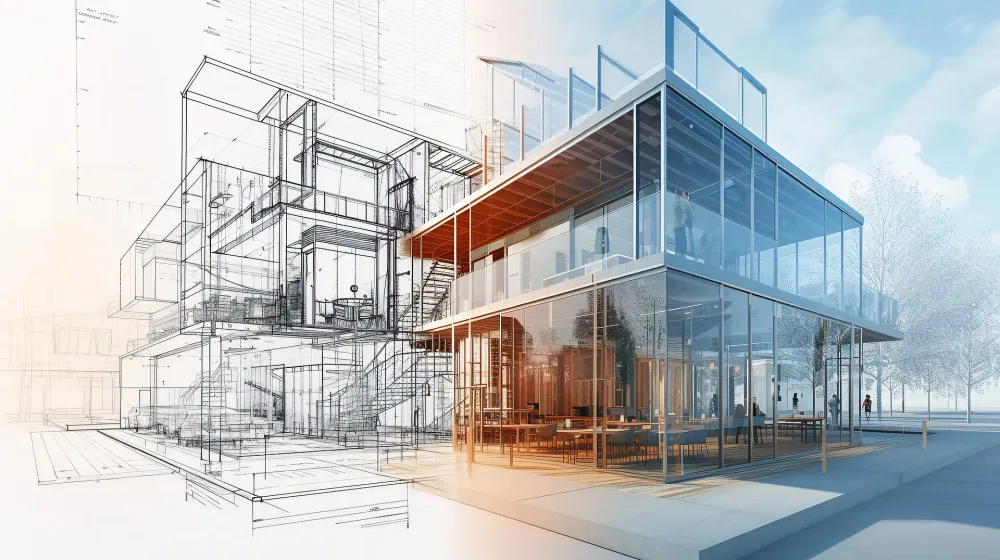Explore how AI is due to the UK's planning system, reducing delays and speeding up decisions.
In some UK councils, it can take up to 18 months for major developments to crawl from submission to decision. That’s not just a delay - it’s a bottleneck throttling housing delivery and stalling commercial infrastructure (not to mention the downstream impact on the wider economy). The opportunity cost of delay is huge - housing targets are missed as reliably as planning officers miss your calls.
So the question is: can artificial intelligence (AI) unclog the system?
The UK’s planning process is infamous for being slow, creaky, and tangled in red tape. Developers wait. Investors hesitate. Planners drown in documentation. This article cuts through the fluff to explore whether AI can genuinely speed things up and how it might change the day-to-day lives of planners, developers, and everyone navigating the system.
What’s Actually Broken in the UK Planning System?
In 2023, only 51% of major planning applications were decided within the statutory 13-week window, down from 83% a decade ago (DLUHC). In overstretched councils, wait times can balloon to 18 months or more.
Why? Because planning departments are stretched to breaking point. Between 2010 and 2020, over 3,100 public sector planners left their roles (RTPI). Systems are still reliant on paper trails, repetitive manual checks, and inconsistent local policies.
The fallout is severe: developers face stalled timelines, investment falls away and planners burn out. Housing delivery suffers most. The government’s '370,000 homes per year' target remains fantasy-level ambitious, with planning delays routinely cited as the top obstacle.

What Can AI Actually Do for Planning?
Let’s skip the sci-fi. AI isn’t here to replace planners - it’s here to relieve them of the bureaucratic quicksand.
Here are four real ways AI is already helping to streamline planning today, plus a glimpse into where it’s heading.
- Spot Policy Conflicts Automatically
What it can do:
AI tools can read and interpret complex policy documents like the NPPF, Local Plans, and design codes - then it cross checks it against your application.
➜ “Does this site meet minimum parking standards?”
➜ “Are four-storey buildings permitted in this character area?”
It understands structure, not just keywords. So in a Local Plan it knows when “encouraged” isn’t the same as “required,” and when “presumption in favour” still has caveats.
How it works:
Using Natural Language Processing (NLP), the AI reads thousands of pages of policy, identifying key terms, relationships between policies, exceptions, and geographic relevance.
- Predict Planning Outcomes Before You Apply
What it can do:
AI tools can now forecast the likelihood of approval for your scheme before you’ve submit. They spot red flags, highlight common objections, and even suggest tweaks to boost your chances.
Example:
➜ “Your proposal has a 64% approval probability in this borough - unless it exceeds three storeys, where success rates drop to 31% due to height restrictions in the local conservation area.”
It’s like predictive due diligence, giving planners and developers a head start.
How it works:
AI models are trained on thousands of historic applications, decisions, and appeal outcomes. They analyse planning context, design features, public objections, site constraints and policy alignment to spot patterns and assess risk.
- Validate Planning Applications in Minutes
What it can do:
AI systems can instantly scan your application and spot missing or inconsistent information - before a human ever sees it.
Example:
➜ “You forgot to explain how your proposal aligns with the local design code in your Design & Access Statement.”
Less back and forth between developers and planning officers means less more time for productive conversations.
How it works:
Trained on past submissions and validation checklists, the AI recognises document types, expected content, and typical omissions. It can cross-reference site location, policy triggers, and document quality to flag what’s missing, saving planners from playing admin detective.
- Generative Design Tools
What it’s doing now:
AI can generate multiple design scenarios - testing layouts against daylight rules, access standards, and density targets.
How it works:
Generative tools iterate through multiple potential site configurations, optimising for various constraints. It’s like giving your architect an AI-powered assistant who never sleeps and loves spreadsheets.
Where it’s going:
We’re heading toward collaborative AI tools that dynamically evolve designs based on planner feedback, policy constraints, or community input - all before pre-app.
Design faster. Design smarter. AI Powered Generative Design in Architecture.
Beyond the Theory: Who’s Already Doing It?
This isn’t just theory. Several UK organisations are already putting AI to work on real planning problems:
- Camden & Southwark Councils – These two London boroughs are piloting AI tools to automate document validation and flag missing or inconsistent information before planners even open the file.
- DLUHC Digital Planning Programme – The Department for Levelling Up, Housing and Communities is rolling out modular, AI-powered planning tools across local authorities to tackle validation, policy checks and data analysis.
Want to see what it looks like in practice? Explore in detail how Camden Council is breaking the mould by using AI to tackle planning delays head-on:
Inside Camden’s AI-Powered Planning Revolution: A New Era for Planning Approvals
What AI Could Mean for You
Developers
- Faster, more predictable outcomes
- Early risk profiling
Planning Consultants
- Policy analysis in seconds
- More time for strategy and client support
Investors
- Predictive risk models for smarter capital deployment
- A clearer outlook on timescales
Planners & Local Authorities
- Less admin
- Faster approvals
- More time for public engagement
Architects
- Generative massing tools will reduce time consuming feasibility work.
- Instant feedback on feasibility and compliance
So… Can AI Streamline Planning, or Just Speed Up the Boring Bits?
AI is already chipping away at the system’s most frustrating inefficiencies - validation, policy checks, and paperwork.
But let’s not confuse momentum with a miracle cure.
The real issues in UK planning aren’t just about speed. They’re about people, policy, and politics. Chronic underfunding. Talent shortages. A regulatory frame that hasn’t caught up with the digital tools now knocking on its door.
Even the best-trained AI can’t overrule contradictory planning guidance. It won’t solve a staffing crisis. And it certainly can’t make the kind of bold, joined-up reforms needed to bring true consistency and certainty to the system.
But here’s what it can do and is already doing:
It’s taking the friction out of everyday planning tasks. It’s making early-stage risk clearer and more data-driven. It’s giving planners and consultants space to think strategically instead of drowning in admin.
And in places like Camden, it’s showing what happens when councils lean in with small, practical steps that actually improve the process. The kind of steps that, if scaled, could reset expectations for how planning gets done in the UK.
This is the start of something.
Whether it scales, and sticks, will depend on leadership as much as technology.
And for more practical, no-fluff AI insights for property professionals:
Sign up to the newsletter to stay up to date on AI and Property.





